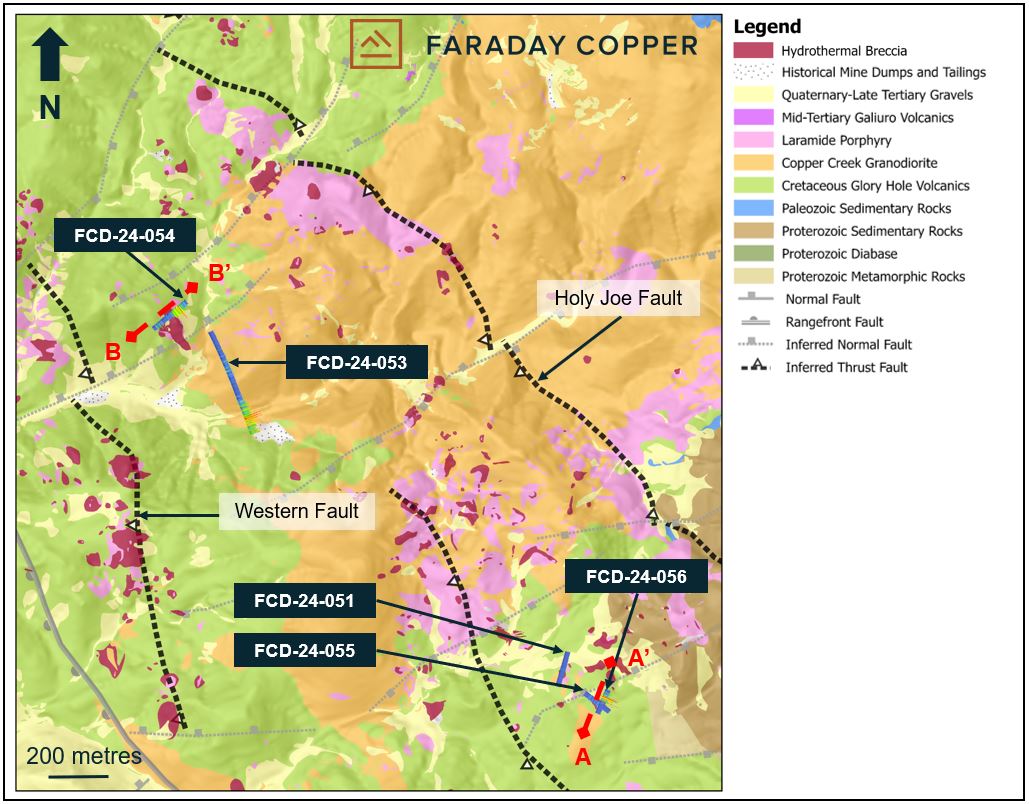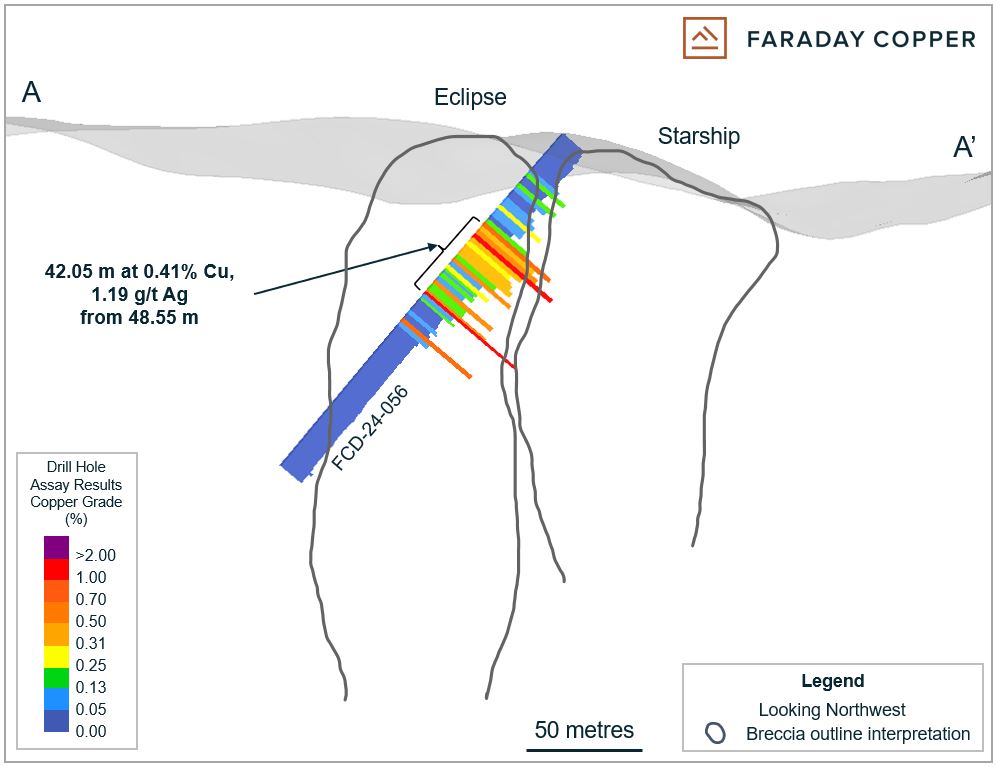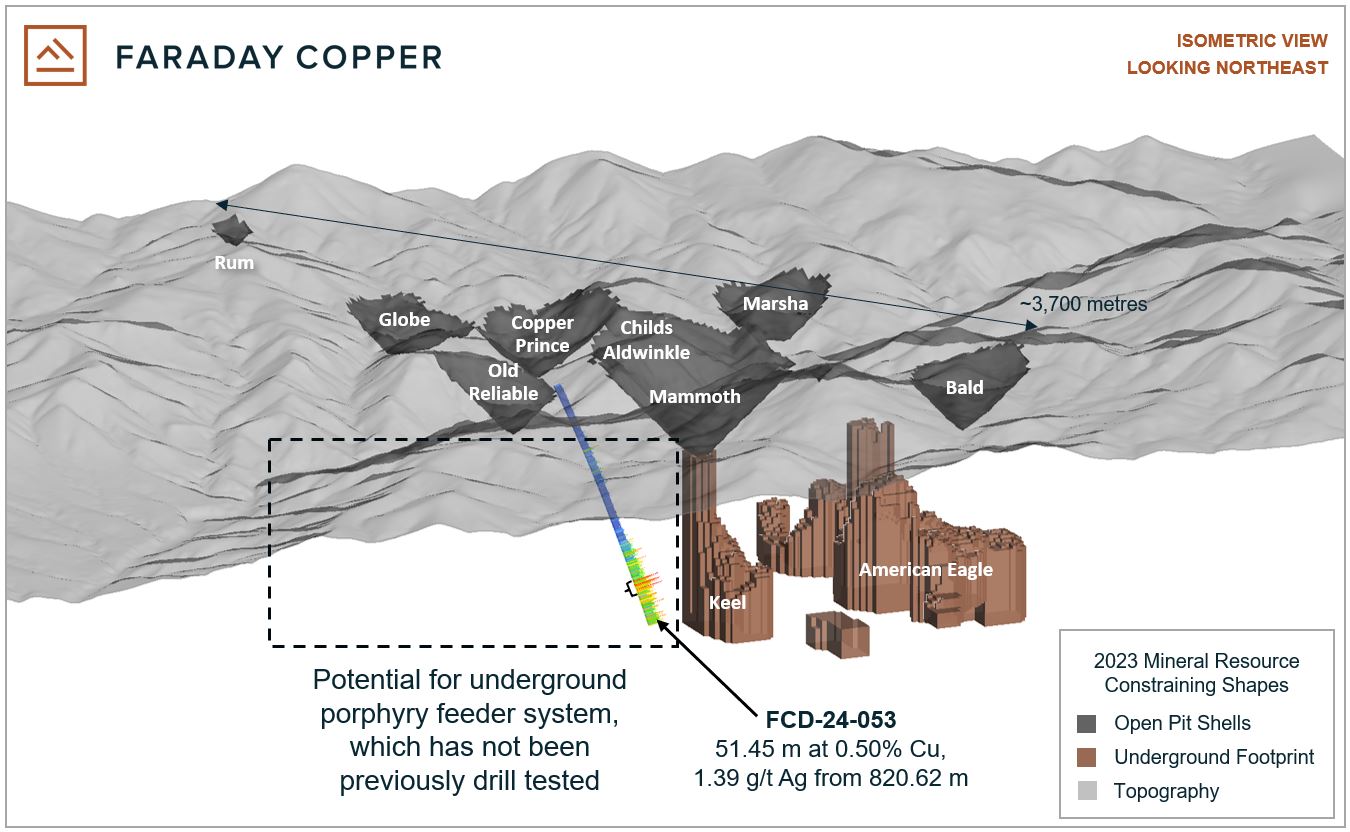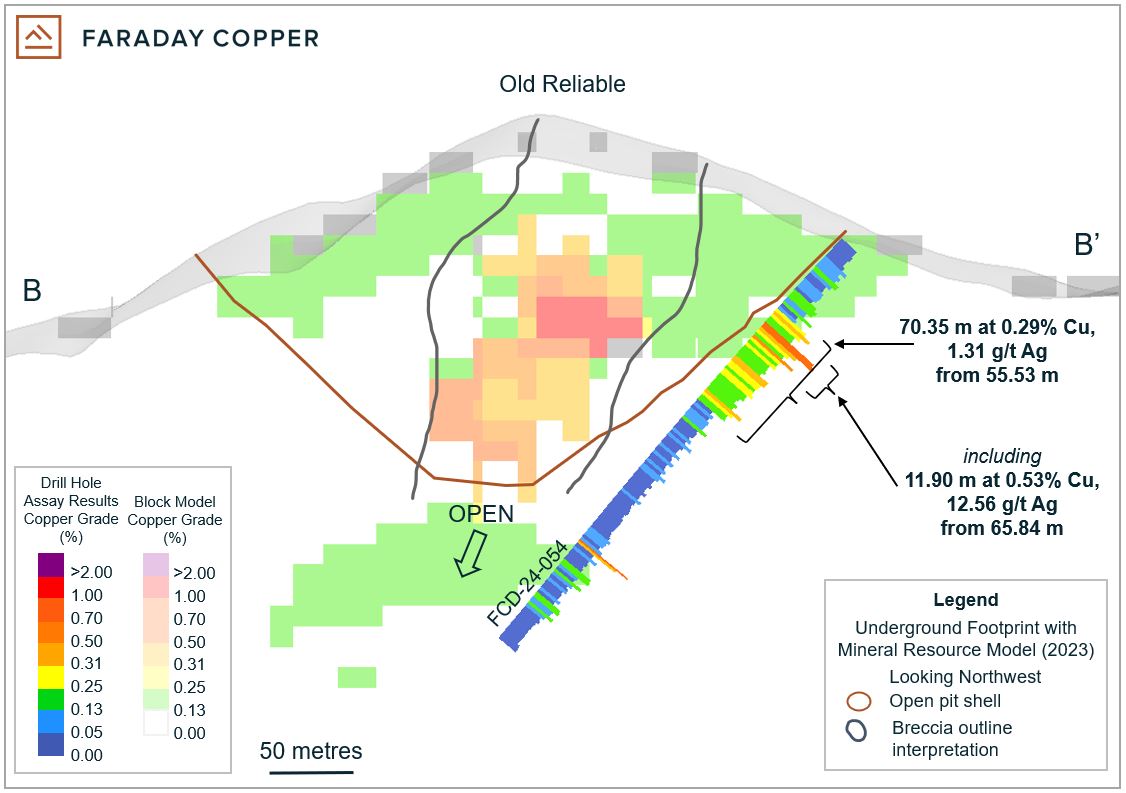Faraday Copper Intersects 0.41% Copper Over 42.02 Metres Expanding Near-Surface Mineralization at Area 51 within the Copper Creek Project
Faraday Copper Corp. (OTCQX: CPPKF) announced positive results from five drill holes in Phase III of the Copper Creek Project in Arizona. Key highlights include:
- Drill hole FCD-24-056 at Area 51 intersected 42.05 meters at 0.41% copper, expanding known mineralization.
- Drill hole FCD-24-053 at Keel West intersected 51.45 meters at 0.50% copper and 1.39 grams per tonne silver, within a longer intercept of 186.90 meters at 0.32% copper.
- Drill hole FCD-24-054 at Old Reliable intersected 70.35 meters of 0.29% copper and 1.31 grams per tonne silver.
The company is focused on expanding mineral resources and delineating high-grade zones through continued drilling. CEO Paul Harbidge emphasized the project's exploration potential. The Phase III program has seen 27 drill holes completed to date, with 19 results released.
- Drill hole FCD-24-056 intersected 42.05 meters at 0.41% copper, expanding known mineralization at Area 51.
- Drill hole FCD-24-053 at Keel West intersected 51.45 meters at 0.50% copper and 1.39 grams per tonne silver, within a longer intercept of 186.90 meters at 0.32% copper.
- Drill hole FCD-24-054 at Old Reliable intersected 70.35 meters of 0.29% copper and 1.31 grams per tonne silver.
- Phase III drilling continues to demonstrate the exploration potential of the Copper Creek Project.
- The company has completed 27 drill holes in Phase III, with 19 reported results showing promising outcomes.
- The project is well-funded and benefits from an experienced management team.
- Drill holes FCD-24-051 and FCD-24-055 did not yield significant intercepts.
- Despite positive drill results, the mineralization grades might not meet high-grade commercial viability for some investors.
- Continued drilling and exploration require significant financial resources, posing potential risks if funding becomes
- The Phase III program's success is not guaranteed and future drilling may not yield comparable results.
VANCOUVER, BC / ACCESSWIRE / May 14, 2024 / Faraday Copper Corp. ("Faraday" or the "Company") (TSX:FDY)(OTCQX:CPPKF) is pleased to announce the results of five drill holes from its Phase III program at the Copper Creek Project, located in Arizona, U.S. ("Copper Creek"). One hole was drilled to test a new target area 275 metres ("m") west of Keel and one hole was drilled to test the westward extension of Old Reliable. Three holes were drilled at Area 51 as a follow-up to the recent Starship and Eclipse breccia discoveries (announced on January 16, 2024 and March 4, 2024).
Paul Harbidge, President and CEO, commented "The Phase III drill program continues to demonstrate the exploration potential of the Copper Creek Project on a number of fronts. At Area 51, we continue to intersect and expand near-surface mineralization. At Old Reliable, mineralization is being further delineated outside of the mineral resource pit shell. Additionally, the first reconnaissance hole drilled at depth, west of Keel, confirms our thesis that there is the potential for significant mineralization to be discovered below the Old Reliable breccia complex. This new data will enable us to vector to high grade zones for further drill testing".
Highlights
- At Area 51, intersected 42.05 m at
0.41% copper from 48.55 m in drill hole FCD-24-056 at the recently discovered Eclipse breccia.- This hole expands the known mineralization within the Eclipse breccia approximately 20 m to the east and 50 m to the north from previous intercepts.
- Drilling 275 m west of Keel ("Keel West") intersected 51.45 m at
0.50% copper and 1.39 grams per tonne ("g/t") silver from 820.62 m in drill hole FCD-24-053. This intercept is within a longer intercept of 186.90 m at0.32% copper from 820.62 m.- This hole is in a previously undrilled area outside the Mineral Resource Estimate ("MRE") and confirms that mineralization is open to the west of Keel and below the Old Reliable breccia.
- Step-out to the west of Old Reliable intersected 70.35 m of
0.29% copper and 1.31 g/t silver from 55.53 m in drill hole FCD-24-054.- Mineralization is hosted in granodiorite porphyry and confirms that near-surface mineralization at Old Reliable remains open.
(For true width information see Table 1.)
Area 51 was identified as highly prospective by integrating airborne versatile time domain electromagnetic (VTEM) geophysical data and short wave infrared spectral data together with geological mapping and sampling. Area 51 encompasses a porphyry intrusion with nine mapped breccia bodies over an area of approximately 400 m by 400 m, including Starship and Eclipse. The breccias are interpreted to have been emplaced at a shallow crustal level in the hanging wall of the northwest trending Holy Joe thrust fault, which brought Proterozoic metamorphic rocks in contact with younger sedimentary rock units to the east of Area 51. This fault is also thought to have controlled the emplacement of the Paleocene Glory Hole volcanics and Copper Creek granodiorite which host the mineral resource.
Drill hole FCD-24-056 was collared northeast of the Eclipse breccia and drilled to the southwest to increase drill coverage for the Eclipse breccia (Figures 1 and 2). Mineralization is associated with chalcopyrite and minor bornite breccia cement. The hole started in granodiorite porphyry and intersected hydrothermal breccia from 28 m to 108 m followed by granodiorite porphyry to 131 m. The remainder of the hole to 187 m is in Glory Hole volcanics. The alteration in the breccia domain is quartz-sericite-pyrite with an interval from approximately 50 m to 70 m where tourmaline is abundant.
Drill hole FCD-24-051 was collared 250 m north of the Eclipse breccia and drilled to the southwest into the Ziltoid breccia (Figure 1). The hole intersected Glory Hole volcanics in the first 180 m, followed by 4 m of granodiorite porphyry. From 184 m to 247 m the dominant lithology is hydrothermal breccia. Alteration at the start of the breccia is sericitic but K-feldspar and biotite dominate from 190 m to the end of the hole.
Drill hole FCD-24-055 was collared southeast of the Eclipse breccia and drilled to the Northwest (Figure 1). The hole intercepted Glory Hole volcanics from surface to 49 m, followed by a series of granodiorite and monzogranite porphyries. From 136 m to 327 m the hole intersected hydrothermal breccia cemented by quartz, pyrite and specular hematite. Alteration within the breccia is intense quartz-sericite. Minor copper mineralization is associated with chalcocite near the upper contact of the breccia.
Keel West is the area between the Keel zone and Old Reliable. This area coincides with a prominent untested geophysical anomaly which extends westward from the known mineralization at the Mammoth breccia and Keel zone to below Old Reliable (Figure 3).
Drill hole FCD-24-053 was collared east of Old Reliable and drilled to the south-southeast (Figures 1 and 3). Mineralization is associated with bornite and chalcopyrite bearing veins with narrow sericite-biotite-K-feldspar alteration halos and the hole ends in mineralization. This type of bornite-rich, vein-hosted mineralization is known to be associated with high-grade mineralization and elevated gold grades at Keel and suggests the potential for other high-grade mineralized centers at depth below known near-surface mineralized breccias in the area.
Old Reliable was the site of small-scale underground mining for copper and molybdenum prior to World War II. Starting in the 1970s, an experimental in-situ leach operation recovered some of the near-surface copper oxide mineralization. The sulphide-hosted mineralization remains in place. During the 1990s, densely spaced vertical drilling led to resource definition to approximately 200 m below surface. Several of those drill holes end in mineralization and the resource is open at depth and laterally. Additional follow up drilling is planned for this area.
Drill hole FCD-24-054 was collared north of Old Reliable and drilled to the southwest (Figures 1 and 4). The hole was designed to test the westward extension of the mineralization outside of the open pit used to constrain the MRE. Mineralization is associated with disseminated and vein-hosted chalcopyrite within granodiorite porphyry. The drill hole intercepted Glory Hole volcanics from surface to 50 m and granodiorite porphyry to 208 m, returning to Glory Hole volcanics to 295 m and granodiorite for the last 12 m. Dominant alteration associated with the mineralization is sericite with kaolinite. Similar alteration is present in the Old Reliable breccia (as discussed in a news release dated April 10, 2024).
Figure 1: Plan View Showing Surface Geology and Location of Drill Holes

Figure 2: Cross Section Showing Drill Hole FCD-24-048 at Area 51

Figure 3: Isometric View Showing Drill Hole FCD-24-053 at Keel West

Note: The open pit shells and underground footprint are based on constraints used in the MRE as presented in the report titled "Copper Creek Project NI 43-101 Technical Report and Preliminary Economic Assessment" with an effective date of May 3, 2023 (the "Technical Report") available on the Company's website at www.faradaycopper.com and on the Company's SEDAR+ profile at www.sedarplus.ca.
Figure 4: Cross Section Showing Drill Hole FCD-24-054 at Old Reliable

Note: The open pit shell is based on constraints used in the MRE as presented in the Technical Report available on the Company's website at www.faradaycopper.com and on the Company's SEDAR+ profile at www.sedarplus.ca.
Table 1: Selected Drill Results from Copper Creek
| Drill Hole ID | From | To | Length | True Width | Cu | Au | Ag | Mo |
(m) | (m) | (m) | (m) | (%) | (g/t) | (g/t) | (%) | |
| FCD-24-053 | 820.62 | 1,007.52 | 186.90 | 186 | 0.32 | 0.02 | 0.99 | 0.0064 |
| including | 820.62 | 872.07 | 51.45 | 51 | 0.50 | 0.01 | 1.39 | 0.0071 |
| FCD-24-054 | 55.53 | 125.88 | 70.35 | 70 | 0.29 | N/A | 1.31 | 0.0002 |
| including | 65.84 | 77.74 | 11.90 | 11 | 0.53 | N/A | 2.56 | 0.0001 |
| FCD-24-056 | 48.55 | 90.60 | 42.05 | 28 | 0.41 | 0.02 | 1.19 | 0.0003 |
| FCD-24-051 | No significant intercepts | |||||||
| FCD-24-055 | No significant intercepts | |||||||
Note: All intercepts are reported as downhole drill widths. Mineralization includes bulk porphyry style and breccia mineralization true widths are approximate due to the irregular shape of mineralized domains. N/A: Not analyzed.
Table 2: Collar Locations from the Drill Holes Reported Herein
| Drill Hole ID | Easting | Northing | Elevation | Azimuth | Dip | Target | Depth | Depth |
(m) | (°) | (°) | (ft) | (m) | ||||
| FCD-24-053 | 547894 | 3624015 | 1169 | 155 | 55 | Keel W | 3,070.9 | 1,007.52 |
| FCD-24-054 | 547784 | 3624164 | 1218 | 228 | 46 | Old Reliable | 936.5 | 307.24 |
| FCD-24-056 | 549747 | 3622351 | 1384 | 205 | 48 | Eclipse | 568.8 | 186.63 |
| FCD-24-051 | 549560 | 3622527 | 1324 | 197 | 45 | Ziltoid | 752.5 | 246.89 |
| FCD-24-055 | 549765 | 3622252 | 1391 | 305 | 65 | Eclipse | 1,118.9 | 367.10 |
Note: Coordinates are given as World Geodetic System 84, Universal Transverse Mercator Zone 12 north (WGS84, UTM12N).
Next Steps
Phase III drilling continues and is focussed on three objectives:
- Reconnaissance drilling on new targets;
- Expanding the MRE; and
- Better delineating high-grade mineralized zones.
As part of the Phase III program, twenty-seven drill holes have been completed and results for nineteen have been released. Thirteen holes were drilled in Area 51, three in the Copper Prince-Copper Giant area, eight in the Bald-American Eagle area and three near Old Reliable. Current focus of drilling is on the near-surface breccias in the American Eagle area.
Sampling Methodology, Chain of Custody, Quality Control and Quality Assurance
All sampling was conducted under the supervision of the Company's geologists and the chain of custody from Copper Creek to the independent sample preparation facility, ALS Laboratories in Tucson, AZ, was continuously monitored. The samples were taken as ½ core, over 2 m core length. Samples were crushed, pulverized and sample pulps were analyzed using industry standard analytical methods including a 4-Acid ICP-MS multielement package and an ICP-AES method for high-grade copper samples. Gold was analyzed on a 30 g aliquot by fire assay with an ICP-AES finish. A certified reference sample was inserted every 20th sample. Coarse and fine blanks were inserted every 20th sample. Approximately
Qualified Person
The scientific and technical information contained in this news release has been reviewed and approved by Faraday's VP Exploration, Dr. Thomas Bissig, P. Geo., who is a Qualified Person under National Instrument 43-101 - Standards of Disclosure for Mineral Projects ("NI 43-101").
About Faraday Copper
Faraday Copper is a Canadian exploration company focused on advancing its flagship copper project in Arizona, U.S. The Copper Creek Project is one of the largest undeveloped copper projects in North America with significant district scale exploration potential. The Company is well-funded to deliver on its key milestones and benefits from a management team and board of directors with senior mining company experience and expertise. Faraday trades on the TSX under the symbol "FDY".
For additional information please contact:
Stacey Pavlova, CFA
Vice President, Investor Relations & Communications
Faraday Copper Corp.
E-mail: info@faradaycopper.com
Website: www.faradaycopper.com
To receive news releases by e-mail, please register using the Faraday website at www.faradaycopper.com.
Cautionary Note on Forward Looking Statements
Some of the statements in this news release, other than statements of historical fact, are "forward-looking statements" and are based on the opinions and estimates of management as of the date such statements are made and are necessarily based on estimates and assumptions that are inherently subject to known and unknown risks, uncertainties and other factors that may cause actual results, level of activity, performance or achievements of Faraday to be materially different from those expressed or implied by such forward-looking statements. Such forward-looking statements and forward-looking information specifically include, but are not limited to, statements concerning the exploration potential of the Copper Creek property.
Although Faraday believes the expectations expressed in such forward-looking statements are based on reasonable assumptions, such statements should not be in any way construed as guarantees of future performance and actual results or developments may differ materially. Accordingly, readers should not place undue reliance on forward-looking statements or information.
Factors that could cause actual results to differ materially from those in forward-looking statements include without limitation: market prices for metals; the conclusions of detailed feasibility and technical analyses; lower than expected grades and quantities of mineral resources; receipt of regulatory approval; receipt of shareholder approval; mining rates and recovery rates; significant capital requirements; price volatility in the spot and forward markets for commodities; fluctuations in rates of exchange; taxation; controls, regulations and political or economic developments in the countries in which Faraday does or may carry on business; the speculative nature of mineral exploration and development, competition; loss of key employees; rising costs of labour, supplies, fuel and equipment; actual results of current exploration or reclamation activities; accidents; labour disputes; defective title to mineral claims or property or contests over claims to mineral properties; unexpected delays and costs inherent to consulting and accommodating rights of Indigenous peoples and other groups; risks, uncertainties and unanticipated delays associated with obtaining and maintaining necessary licenses, permits and authorizations and complying with permitting requirements, including those associated with the Copper Creek property; and uncertainties with respect to any future acquisitions by Faraday. In addition, there are risks and hazards associated with the business of mineral exploration, development and mining, including environmental events and hazards, industrial accidents, unusual or unexpected formations, pressures, cave-ins, flooding and the risk of inadequate insurance or inability to obtain insurance to cover these risks as well as "Risk Factors" included in Faraday's disclosure documents filed on and available at www.sedarplus.ca.
This press release does not constitute an offer to sell or a solicitation of an offer to buy any securities in any jurisdiction to any person to whom it is unlawful to make such an offer or solicitation in such jurisdiction. This press release is not, and under no circumstances is to be construed as, a prospectus, an offering memorandum, an advertisement or a public offering of securities in Faraday in Canada, the United States or any other jurisdiction. No securities commission or similar authority in Canada or in the United States has reviewed or in any way passed upon this press release, and any representation to the contrary is an offence.
SOURCE: Faraday Copper Corp.
View the original press release on accesswire.com
FAQ
What are the latest drill results from Faraday Copper's Copper Creek Project?
What was the copper grade intersected at Keel West in Faraday Copper's recent drilling?
How did the drill hole at Old Reliable perform in Faraday Copper's Phase III program?
What is the significance of the recent drill results at Area 51 within Copper Creek?
How many drill holes have been completed in Faraday Copper's Phase III program?







